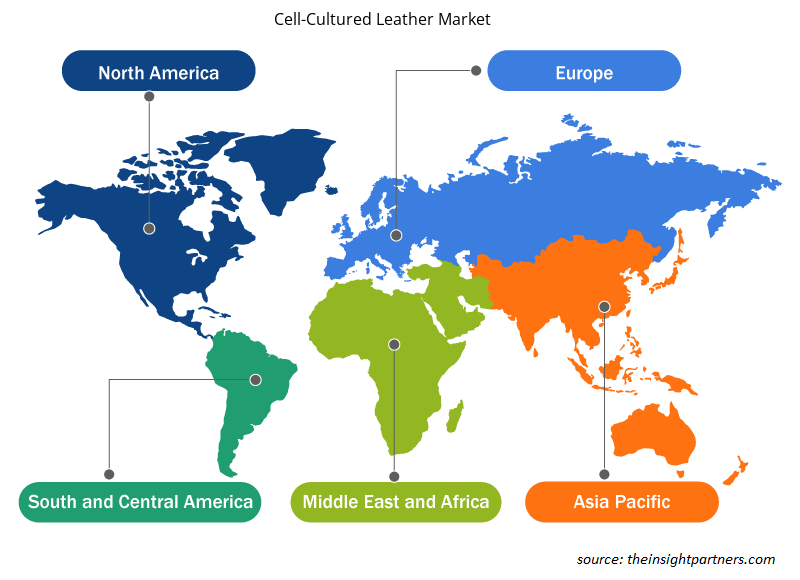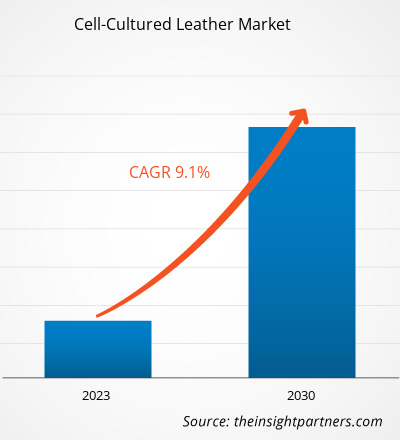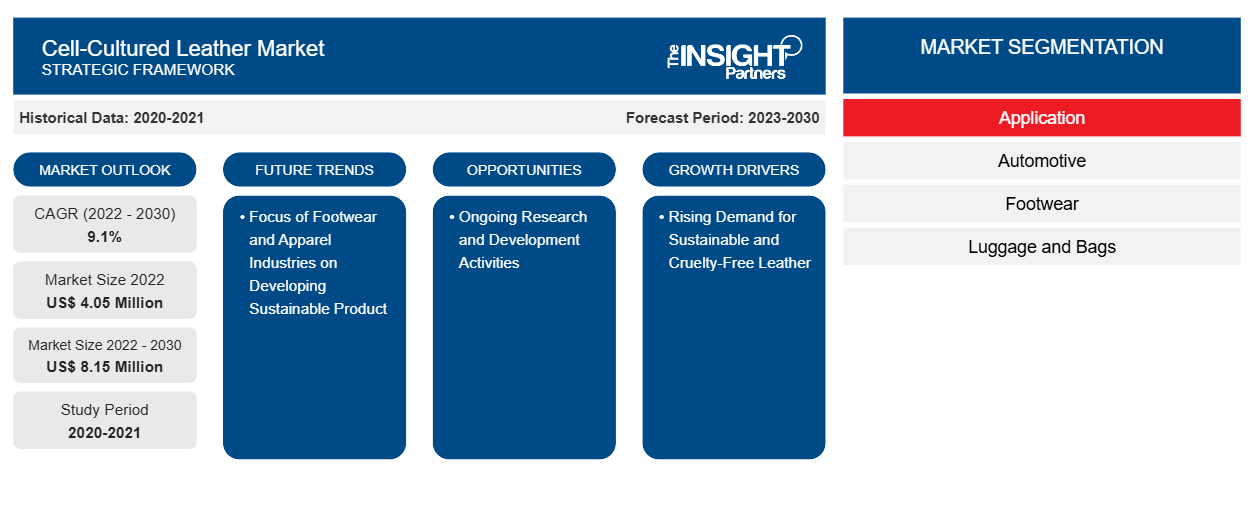[研究报告] 2022 年细胞培养皮革市场规模价值 405 万美元,预计到 2030 年将达到 815 万美元;预计 2022 年至 2030 年的复合年增长率为 9.1%。
市场洞察和分析师观点:
细胞培养皮革由酵母细胞、生物基支架、胶原蛋白和生物反应器制成。细胞培养皮革市场的参与者利用其专利技术制造细胞培养皮革。细胞培养皮革用于汽车、鞋类、箱包、服装等应用。对可持续和无残忍皮革的不断增长的需求主要推动了细胞培养皮革市场的发展。此外,耐用性、强度和更少的环境足迹等有益特性是推动细胞培养皮革市场增长的其他因素。此外,许多公司和品牌正在放弃合成材料,使其皮革完全可堆肥和可生物降解。因此,对细胞培养皮革的需求正在增加,预计未来几年将进一步增长。此外,北美和欧洲是细胞培养皮革市场的主要地区。这些地区对细胞培养皮革的需求是由人们对传统皮革制造工艺的认识不断提高以及消费者对可持续产品的需求不断增加所驱动的。
增长动力和挑战:
近年来,人们对皮革鞣制和生产过程中的动物虐待因素和对环境的有害影响产生了很大的担忧。通过传统方法,人们屠宰了许多牲畜以获取皮革。此外,饲养这些动物需要大量的土地和水资源。养牛每年占全球温室气体排放量的很大一部分。鞣制过程污染严重,其中动物皮毛经过处理以生产皮革。近 80-90% 的皮革经过铬处理。铬是一种有毒化学物质,如果处理不当会污染水道。它还会损害使用它的工人的健康。因此,人们对传统皮革制造的道德和环境问题日益关注,推动了对替代品的需求,例如细胞培养皮革。细胞培养皮革是皮革生产过程中当前做法的更可持续的替代方案。细胞培养皮革克服了对动物屠宰的需求,还有助于减少与皮革生产相关的碳排放。细胞培养皮革生产减少了皮革鞣制过程中产生的一些危险和毒素。这对环境和皮革行业的工人都有好处。然而,市场上替代产品的供应阻碍了细胞培养皮革市场的增长。细胞培养皮革的替代产品是传统皮革、聚氨酯皮革、聚氯乙烯和生物基材料。与其他替代品相比,传统皮革有各种优势,比如使用寿命长。此外,与大多数人造或合成材料不同,它会随着时间的推移而变得更好。此外,聚氨酯和聚氯乙烯制成的皮革具有成本效益。生物基皮革由蘑菇、菠萝、苹果、仙人掌和树皮制成;它更环保,无残忍。素食主义的兴起使人们需要用这些生物基材料制成的皮革。由于细胞培养皮革是由动物细胞制成的,因此它否定了声称标签为素食或无动物的可能性。
定制此报告以满足您的需求
您可以免费定制任何报告,包括本报告的部分内容、国家级分析、Excel 数据包,以及为初创企业和大学提供优惠和折扣
-
获取此报告的关键市场趋势。这个免费样品将包括数据分析,从市场趋势到估计和预测。
报告细分和范围:
全球细胞培养皮革市场根据应用和地域进行细分。根据应用,细胞培养皮革市场细分为汽车、鞋类、行李箱和包袋、服装等。根据地域,细胞培养皮革市场细分为北美、欧洲、亚太地区和世界其他地区。
节段分析: Analysis:
根据应用,细胞培养皮革市场细分为汽车、鞋类、箱包、服装等。服装部分在细胞培养皮革市场中占有最大份额,预计在研究期间将实现显着增长。在服装行业,夹克、外套、裤子、衬衫等都可以用细胞培养皮革制成。服装行业的各家公司都专注于开发可持续时尚产品,这需要使用可持续材料。许多品牌都在积极将可持续性纳入其战略,消费者对可持续时尚产品的需求也很高。品牌和公司的不同举措进一步为细胞培养皮革市场的增长提供了机会。
区域分析:
根据地理位置,细胞培养皮革市场分为主要区域——北美、欧洲、亚太地区和世界其他地区。全球细胞培养皮革市场以北美为主,2022 年的市场规模超过 200 万美元。在北美,对鞋类、行李箱和包袋以及服装产品的需求不断增长,以及对使用可持续产品的日益关注,为细胞培养皮革市场的增长提供了机会。欧洲是第二大贡献者,预计 2022 年至 2030 年将实现显着的增长率。欧洲是细胞培养皮革市场的主要地区之一。法国、英国、德国和意大利等欧洲国家对可持续产品的需求快速增长为细胞培养皮革市场提供了巨大的市场增长潜力。爱马仕和巴黎世家等各种奢侈时尚品牌都在倡导皮革替代品,为细胞培养皮革市场的增长提供了机会。
行业发展和未来机遇:
以下列出了细胞培养皮革市场的主要参与者采取的各种举措:
- 2022 年,VitroLabs Inc 筹集了 4600 万美元,用于建设和扩大世界上第一个细胞培养皮革试点生产。A 轮融资由 Agronomics 领投;其他投资者包括 BESTSELLER 的 Invest FWD、全球奢侈品集团 Kering、Khosla Ventures、演员兼环保主义者 Leonardo DiCaprio、New Agrarian 和 Regeneration.VC。此外,Kering 继续与 VitroLabs Inc 合作,为产品质量测试、鞣制和精加工提供支持。
- 2021 年,Qorium 筹集了 260 万欧元(275 万美元),用于扩大研发规模,扩大其基于细胞培养胶原蛋白的皮革技术。
- 2023年,Modern Meadow 获得 D 轮融资,本轮融资由 Astanor Ventures、Horizons Ventures 和 Key Partners Capital 领投,将支持 Modern Meadow 继续创新。
细胞培养皮革市场区域洞察
Insight Partners 的分析师已详尽解释了预测期内影响细胞培养皮革市场的区域趋势和因素。本节还讨论了北美、欧洲、亚太地区、中东和非洲以及南美和中美洲的细胞培养皮革市场细分和地理位置。

- 获取细胞培养皮革市场的区域特定数据
细胞培养皮革市场报告范围
| 报告属性 | 细节 |
|---|---|
| 2022 年市场规模 | 405万美元 |
| 2030 年的市场规模 | 815万美元 |
| 全球复合年增长率(2022 - 2030 年) | 9.1% |
| 史料 | 2020-2021 |
| 预测期 | 2023-2030 |
| 涵盖的领域 |
按应用
|
| 覆盖地区和国家 |
北美
|
| 市场领导者和主要公司简介 |
|
市场参与者密度:了解其对商业动态的影响
细胞培养皮革市场正在快速增长,这得益于最终用户需求的不断增长,这些需求源于消费者偏好的不断变化、技术进步以及对产品优势的认识不断提高等因素。随着需求的增加,企业正在扩大其产品范围,进行创新以满足消费者的需求,并利用新兴趋势,从而进一步推动市场增长。
市场参与者密度是指在特定市场或行业内运营的企业或公司的分布情况。它表明相对于给定市场空间的规模或总市场价值,有多少竞争对手(市场参与者)存在于该市场空间中。
在细胞培养皮革市场运营的主要公司有:
- VitroLabs 公司
- 现代草地
- 科里姆
免责声明:上面列出的公司没有按照任何特定顺序排列。

- 获取细胞培养皮革市场顶级关键参与者概述
COVID-19 影响:
在疫情爆发之前,细胞培养皮革市场主要受各个终端使用部门对无残忍皮革需求不断增长的推动。COVID-19 疫情影响了各国几乎所有行业。北美、欧洲、亚太地区和世界其他地区的封锁、旅行限制和企业停工阻碍了包括化学和材料行业在内的多个行业的增长。公司制造部门的关闭扰乱了全球供应链、制造活动和交付计划。2020 年,各公司的产品交付延迟,产品销量下滑。疫情带来了各种经济挑战,对不同地区的细胞培养皮革市场增长产生了负面影响。大多数行业,如汽车、鞋类和服装,都受到了疫情的负面影响,减少了细胞培养皮革的消费。疫情对与细胞培养皮革相关的研发活动以及伙伴关系和合作项目产生了不利影响。疫情导致汽车生产停工,减少了对包括皮革在内的不同产品的需求。
然而,在供应限制得到解决后,各行业都恢复了运营。此外,汽车、鞋类和服装行业对细胞培养皮革的需求不断增长,大大促进了细胞培养皮革市场的增长。
竞争格局和重点公司:
细胞培养皮革市场中的几家主要参与者是 VitroLabs Inc、MODERN MEADOW 和 Qorium。市场参与者专注于研发活动,以生产高质量的产品,满足各个应用行业的客户需求。
- 历史分析(2 年)、基准年、预测(7 年)及复合年增长率
- PEST和SWOT分析
- 市场规模、价值/数量 - 全球、区域、国家
- 行业和竞争格局
- Excel 数据集
近期报告
相关报告
客户评价
购买理由
- 明智的决策
- 了解市场动态
- 竞争分析
- 客户洞察
- 市场预测
- 风险规避
- 战略规划
- 投资论证
- 识别新兴市场
- 优化营销策略
- 提升运营效率
- 顺应监管趋势























 获取免费样品 - 细胞培养皮革市场
获取免费样品 - 细胞培养皮革市场